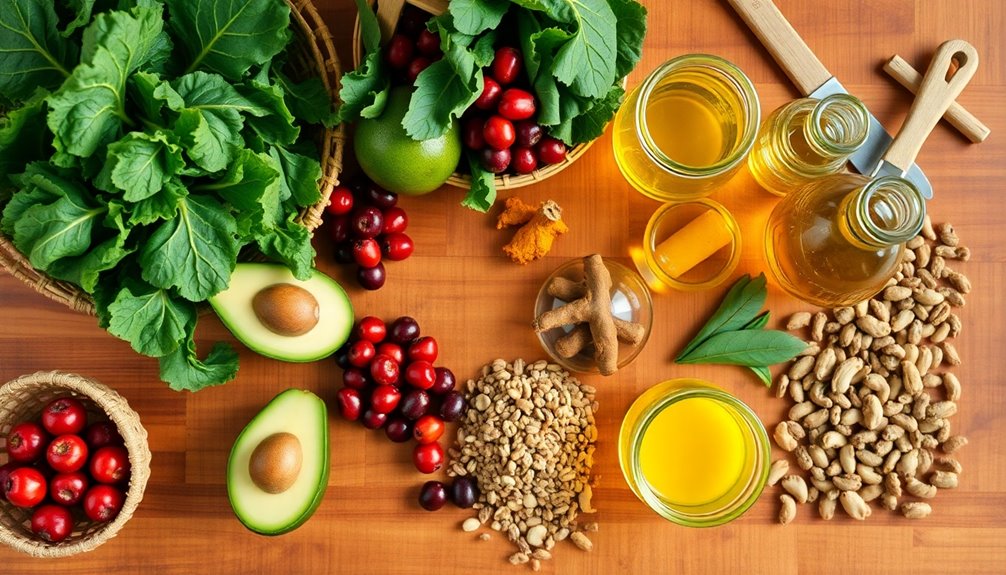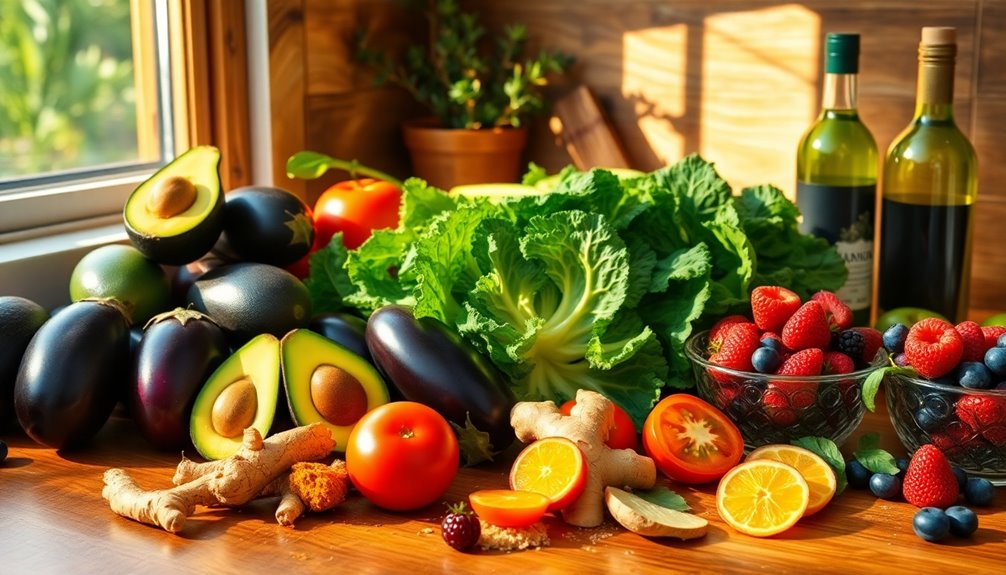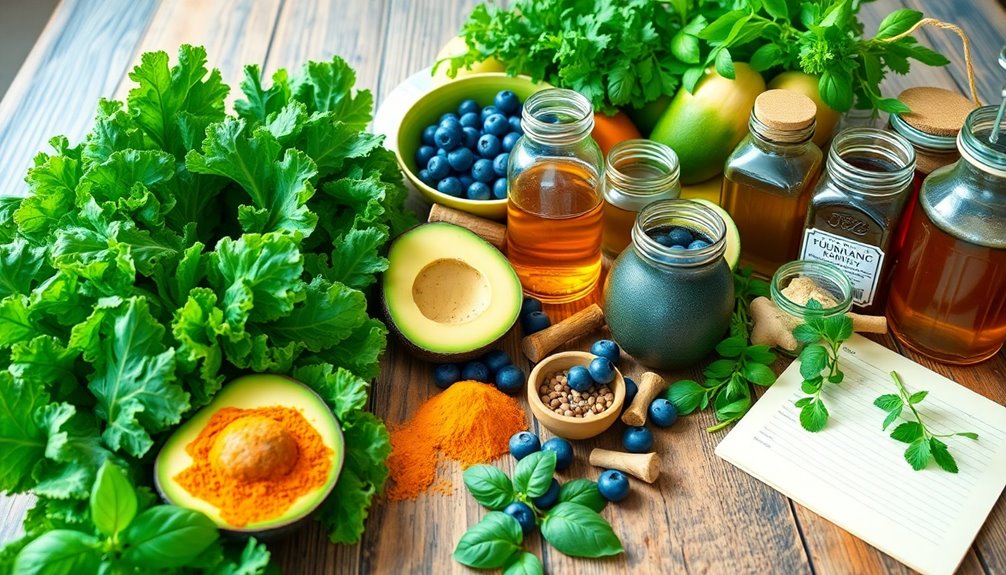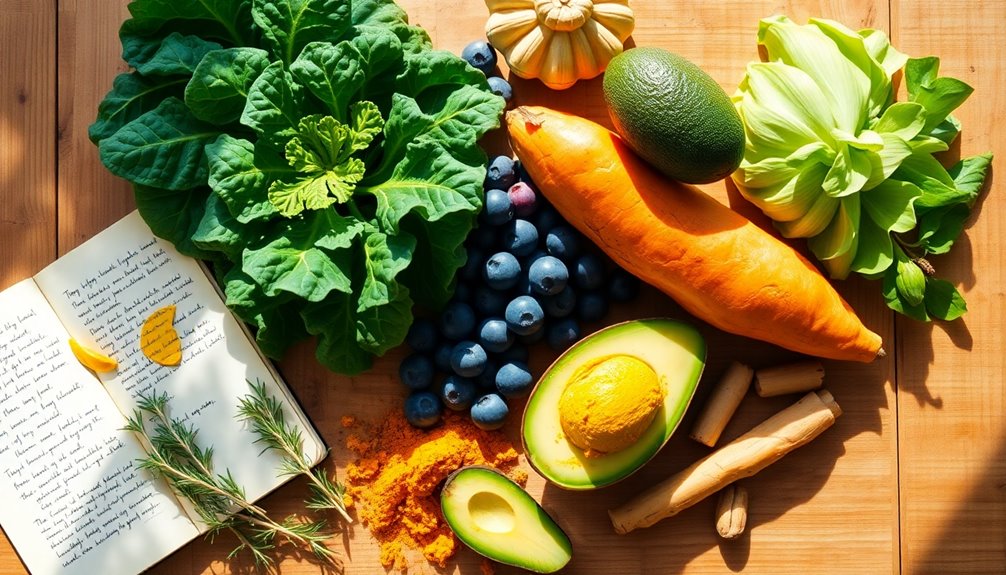To construct an anti-inflammatory grocery list, begin by incorporating a vibrant variety of fruits and vegetables packed with antioxidants. Integrate healthy fats from olive oil, avocados, and fatty fish like salmon, which aid in reducing inflammation. Opt for whole grains for fiber, such as quinoa and brown rice. Remember to replenish your supply of anti-inflammatory spices, like turmeric and ginger. Steer clear of processed foods rich in sugar, trans fats, and refined carbohydrates. Organizing your meals around seasonal produce guarantees freshness and cost-effectiveness. By following these suggestions, you can compile a list that fosters improved health and well-being. Further insights are available on enhancing your selections.
Key Takeaways
- Include a variety of colorful fruits and vegetables rich in antioxidants to combat inflammation.
- Choose lean proteins, such as fish, chicken, beans, and legumes, for anti-inflammatory benefits.
- Stock up on anti-inflammatory spices like turmeric, ginger, and garlic to enhance meals.
- Opt for whole grains to provide fiber and support gut health.
- Plan meals around seasonal produce for freshness and cost-effectiveness.
Understanding Inflammation

What exactly is inflammation, and why should you care? Inflammation is your body's natural response to injury or infection. When your body detects a threat, it sends out immune cells to promote healing. However, when this response becomes persistent, it can lead to various health issues, ranging from arthritis to heart disease. Understanding inflammation's causes and symptoms can empower you to take control of your health.
The causes of inflammation are multifaceted. They can include poor diet, lack of exercise, stress, and environmental factors. Symptoms often present as redness, swelling, heat, and pain in the affected area, but you might also experience fatigue or fever. Recognizing these signs is essential, as they can indicate that your body is in distress.
The health effects of chronic inflammation can be grave. It's linked to numerous diseases, including diabetes, obesity, and even some cancers. By addressing inflammation proactively, you can markedly reduce your risk. Prevention is key here. Adopting a balanced diet rich in anti-inflammatory foods, exercising regularly, managing stress, and getting enough sleep are all effective strategies. Additionally, considering all-natural supplements like NeuroPure for healthy nerve support can further enhance your wellness journey.
You're not alone in this journey; many share the goal of leading a healthier life. By understanding inflammation and its implications, you can make informed choices that promote your well-being and foster a sense of belonging in a community focused on health. Take these insights to heart, and you'll be better equipped to navigate your health journey.
Key Anti-Inflammatory Foods

To combat inflammation effectively, incorporating key anti-inflammatory foods into your diet is crucial. These foods can help you reduce inflammatory triggers and promote overall health.
Begin by embracing fruits and vegetables, especially those rich in antioxidants like berries, leafy greens, and cruciferous vegetables. These powerhouse foods not only fight inflammation but also add vibrant colors to your plate.
Another essential category is healthy fats. Foods like olive oil, avocados, and fatty fish—such as salmon and mackerel—are excellent sources of omega-3 fatty acids, which have been shown to decrease inflammation. When making dietary swaps, consider replacing saturated fats from butter or processed snacks with these healthier options.
Whole grains, like quinoa, brown rice, and oats, can also play a significant role in reducing inflammation. They provide fiber, which supports gut health and helps balance your body's inflammatory responses.
Don't forget about spices and herbs! Turmeric, ginger, and garlic aren't just flavor enhancers; they possess anti-inflammatory properties that can be easily integrated into your meals.
Lastly, legumes such as lentils and beans are packed with protein and fiber, making them fantastic alternatives to meat, which can sometimes trigger inflammation. By consciously choosing these key anti-inflammatory foods and making simple dietary swaps, you can create a nourishing environment for your body, enhancing your health and well-being. Additionally, incorporating effective exercise routines can further assist in managing inflammation and improving overall wellness.
Building Your Grocery List

When building your grocery list, focus on selecting foods that support an anti-inflammatory lifestyle. This approach not only benefits your health but also fosters a sense of community as you share meals with loved ones. Start by making sure you include a mix of fresh produce, whole grains, and healthy fats. Here are three key categories to contemplate:
- Fruits and Vegetables: Aim for a colorful variety. Berries, leafy greens, and cruciferous veggies like broccoli are excellent choices. They're packed with antioxidants and vitamins that combat inflammation.
- Protein Sources: Choose lean proteins like fish, chicken, beans, and legumes. These not only contribute to muscle health but also provide essential nutrients that can help reduce inflammation.
- Pantry Staples: Stock your pantry with anti-inflammatory spices such as turmeric and ginger, along with whole grains like quinoa and brown rice. These staples can serve as budget options without compromising nutritional value. Additionally, consider incorporating grain-free keto bread options, which can provide a healthier alternative to traditional bread that may contribute to inflammation.
When planning your list, ponder how these foods can work together in meals. This not only helps you stay on track with healthy eating but also makes meal prep easier.
Don't forget to look for sales and discounts that allow you to make smart choices without breaking the bank. By thoughtfully building your grocery list, you're investing in your health while also creating opportunities to connect with others through shared meals and experiences.
Tips for Smart Shopping

Smart shopping is key to sticking to your anti-inflammatory grocery list while staying within budget. To accomplish this, start by planning your meals around seasonal produce. Not only will this guarantee you're getting the freshest ingredients, but seasonal fruits and vegetables are often more affordable and packed with nutrients. Check your local farmer's market or grocery store flyers to see what's in season and plan your meals accordingly.
Next, look for budget-friendly options. Store brands often offer similar quality at a lower price. Don't hesitate to compare prices per unit; sometimes, larger quantities of an item can save you money in the long run. Additionally, consider buying frozen fruits and vegetables, which retain their nutritional value and can be more cost-effective than fresh items that may spoil quickly.
Make a shopping list based on your meal plan and stick to it. This reduces impulse buys and keeps you focused on your anti-inflammatory choices.
If you find yourself tempted by processed snacks or sugary treats, remember that they can contribute to inflammation, countering your health efforts. Incorporating a plant-based diet can also provide numerous health benefits that support your anti-inflammatory goals.
Meal Ideas and Recipes

Creating anti-inflammatory meals doesn't have to be complicated or time-consuming. You can easily whip up delicious dishes that support your health and well-being. Consider integrating these meal ideas into your weekly routine:
- Anti-inflammatory smoothies: Start your day with a smoothie packed with spinach, berries, and a scoop of turmeric. This combo not only tastes great but also provides antioxidants and anti-inflammatory properties.
- Quinoa and black bean salad: Combine cooked quinoa with black beans, cherry tomatoes, avocado, and a squeeze of lime. This plant-based meal is rich in fiber and protein, making it filling and nutritious.
- Roasted vegetable stir-fry: Toss your favorite seasonal vegetables—like broccoli, bell peppers, and carrots—in olive oil, garlic, and ginger. Roast them to perfection and serve over brown rice or quinoa for a hearty dish.
Incorporating whole-food protein into your meals enhances nutrient density and supports your overall health. These meal ideas not only cater to your health goals but also foster a sense of community as you share them with family and friends. You'll find that eating well can be a joyful experience, bringing people together to enjoy wholesome, plant-based meals.
Plus, experimenting with flavors and ingredients can ignite your creativity in the kitchen. Remember, when you prioritize anti-inflammatory foods, you're making a positive choice for your body and your loved ones. So grab those ingredients, and start cooking your way to better health!
Frequently Asked Questions
Can Supplements Replace Anti-Inflammatory Foods on My Grocery List?
Supplements can't fully replace anti-inflammatory foods on your grocery list. While they may offer some benefits, their effectiveness often hinges on how well your body absorbs nutrients from whole foods.
Eating a variety of fruits, vegetables, and healthy fats promotes better nutrient absorption and provides essential compounds that supplements often lack.
For best health outcomes, it's ideal to combine both strategies, ensuring you get diverse nutrients for a balanced, anti-inflammatory diet.
How Do I Know if a Food Is Anti-Inflammatory?
To determine if a food's anti-inflammatory, focus on its nutrient profile. Anti-inflammatory food sources, like leafy greens, berries, and fatty fish, are rich in antioxidants and omega-3 fatty acids.
On the other hand, inflammatory food alternatives, such as processed sugars and trans fats, can trigger inflammation. By learning to read labels and recognizing these patterns, you'll make informed choices that support your health and well-being.
Your body will thank you for it!
Are There Specific Brands for Anti-Inflammatory Products?
When you're seeking anti-inflammatory products, you'll find a mix of premium brands and budget-friendly options. Look for brand recommendations like Dr. Bronner's for oils or Nature's Path for cereals, which offer quality without breaking the bank. Remember, health doesn't have to be expensive.
Explore local stores or online resources for sales, ensuring you can nourish your body while staying within your budget. You can support your wellness journey without sacrificing community.
How Long Do Anti-Inflammatory Foods Stay Fresh?
Anti-inflammatory foods can vary in freshness depending on their type and storage. In general, fruits and vegetables last longer when you store them properly. Leafy greens might only last a week, while root vegetables can keep for several weeks. Seasonal produce tends to be fresher and more flavorful, so you'll enjoy them more. Always check for signs of spoilage, and remember that proper storage can extend their shelf life greatly.
Can I Eat Out While Maintaining an Anti-Inflammatory Diet?
Did you know that nearly 60% of people dining out choose healthier options when given the chance?
You can definitely eat out while sticking to an anti-inflammatory diet. Look for restaurant options that feature grilled proteins, lots of vegetables, and whole grains. Even fast food alternatives often offer salads or wraps that can fit your needs. Just focus on making choices that prioritize whole, unprocessed ingredients, and you'll enjoy dining out without compromising your health.
Conclusion
By focusing on anti-inflammatory foods, you can transform your grocery list into a powerful tool for better health. Think of it as stocking your kitchen with nature's pharmacy, where vibrant vegetables, healthy fats, and whole grains work together to fight inflammation. As you shop wisely and prepare delicious meals, you'll not only nourish your body but also support your overall well-being. Embrace this journey, and let your grocery cart be a proof of your commitment to health.



